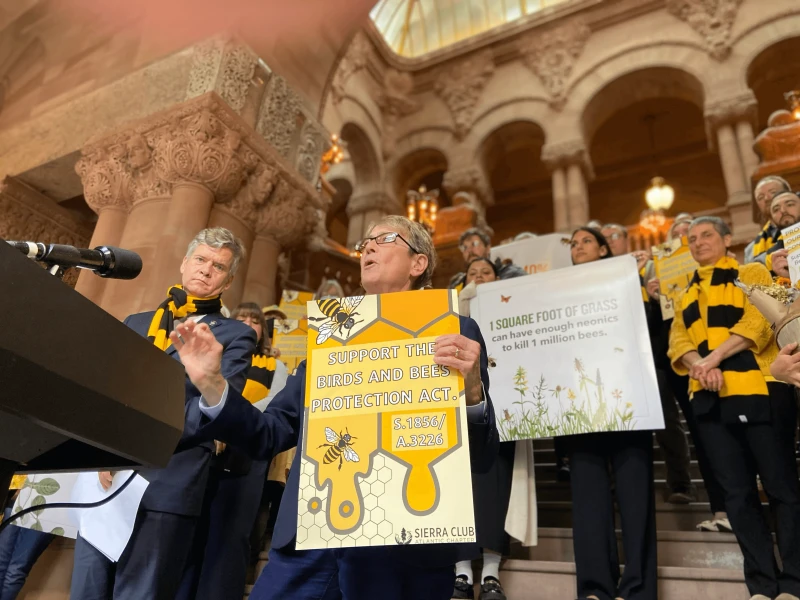Viewpoint: With only 4% of New York farmland organic, why is the state letting this narrow special interest group dictate crop protection policy for all farmers?
Viewpoint: With only 4% of New York farmland organic, why is the state letting this narrow special interest group dictate crop protection policy for all farmers?


Farmers in New York State face a [difficult] situation today due to rising cases of pest infestation, adverse weather events, and a dip in commodity prices. The state needs to do its utmost not to let bad farming conditions cascade into even greater catastrophe. However, it has failed in that responsibility.
A new bill passed by the NY legislature and signed by Gov. Hochul on Dec. 22 is set to add major headaches for farmers and consumers alike. In June, lawmakers passed the Birds and Bees Protection Act, which would ban the use of neonicotinoid insecticides in the state. The NY Senate bill alleges that this would protect pollinators, despite the absence of evidence that bees are hurt by the use of these crop protection chemicals.
There are ideological priorities at work here. A set of activists in the state and beyond oppose any type of chemical crop protection [or pesticide] use, and seek any opportunity to ban it. A recent open letter to Gov. Hochul says as much — signed by 100 growers, almost all of whom are organic growers, calling for her to sign the bill. While it is the prerogative of those growers to abstain from conventional crop protection, they should not get to undermine the choices of other growers and of the consumers who buy the products. As a reminder, only 4% of NY state farmland is organic. While higher than the 0.6% national number, it still represents a priority for only a small number of growers.
This is an excerpt. Read the original post here

 | Videos | More... |

Video: Nuclear energy will destroy us? Global warming is an existential threat? Chemicals are massacring bees? Donate to the Green Industrial Complex!
 | Bees & Pollinators | More... |

GLP podcast: Science journalism is a mess. Here’s how to fix it

Mosquito massacre: Can we safely tackle malaria with a CRISPR gene drive?

Are we facing an ‘Insect Apocalypse’ caused by ‘intensive, industrial’ farming and agricultural chemicals? The media say yes; Science says ‘no’
 | Infographics | More... |

Infographic: Global regulatory and health research agencies on whether glyphosate causes cancer
 | GMO FAQs | More... |

Why is there controversy over GMO foods but not GMO drugs?

How are GMOs labeled around the world?

How does genetic engineering differ from conventional breeding?
 | GLP Profiles | More... |

Alex Jones: Right-wing conspiracy theorist stokes fear of GMOs, pesticides to sell ‘health supplements’




 Viewpoint — Fact checking MAHA mythmakers: How wellness influencers and RFK, Jr. undermine American science and health
Viewpoint — Fact checking MAHA mythmakers: How wellness influencers and RFK, Jr. undermine American science and health Viewpoint: Video — Big Solar is gobbling up productive agricultural land and hurting farmers yet providing little energy or sustainabilty gains
Viewpoint: Video — Big Solar is gobbling up productive agricultural land and hurting farmers yet providing little energy or sustainabilty gains Fighting deforestation with CO2: Biotechnology breakthrough creates sustainable palm oil alternative for cosmetics
Fighting deforestation with CO2: Biotechnology breakthrough creates sustainable palm oil alternative for cosmetics Trust issues: What happens when therapists use ChatGPT?
Trust issues: What happens when therapists use ChatGPT? 30-year-old tomato line shows genetic resistance to devastating virus
30-year-old tomato line shows genetic resistance to devastating virus California, Washington, Oregon forge immunization alliance to safeguard vaccine access against federal undermining
California, Washington, Oregon forge immunization alliance to safeguard vaccine access against federal undermining The free-range chicken dilemma: Better for birds, but with substantial costs
The free-range chicken dilemma: Better for birds, but with substantial costs ‘You have to treat the brain first’: Rethinking chronic pain with Sanjay Gupta
‘You have to treat the brain first’: Rethinking chronic pain with Sanjay Gupta
